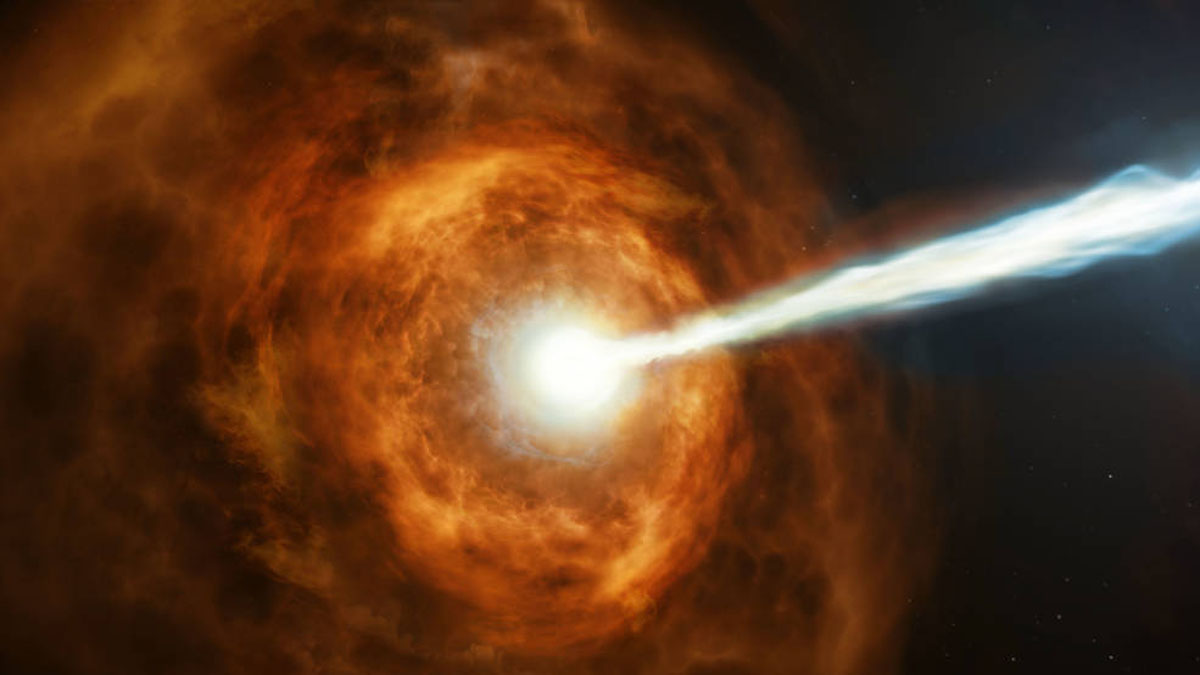The most powerful explosions in the universe could reveal where gold comes from
"The inspiration for this particular study came from conversations with my kids."

Gamma-ray bursts, the most powerful kinds of explosions known in the cosmos, may help provide a piece of the puzzle when it comes to one of the most challenging open problems in all of physics — how the universe's heaviest elements are forged.
A new study's findings suggest that extraordinarily powerful light from gamma-ray bursts might help produce these elements from the outer shells of dying stars.
Previously, research has suggested the formation of the heaviest elements, such as gold, requires copious amounts of neutrons that atomic nuclei can absorb to become larger and larger. But because of this, "scientists assumed that heavy elements were created only in places where neutrons already existed in large quantities," study lead author Matthew Mumpower, a physicist at Los Alamos National Laboratory in New Mexico, told Space.com.
Normally, neutrons are bound within atomic nuclei or in the matter making up extraordinarily powerful stars called neutron stars. Nuclear reactions such as fission or fusion can free neutrons from their binds to help generate heavy elements — however, "free neutrons typically decay within about 15 minutes," Mumpower said. This limits the number of potential situations in which free neutrons are available in the abundance required to form heavy elements only to a few rare scenarios. One of those scenarios is the catastrophic merger of two neutron stars.
"I've been studying the origin of the heavy elements for 20 years," Mumpower said. "It keeps me hooked because there are so many unknowns, making it one of the most difficult problems to solve in all of physics."
Now, Mumpower and his colleagues suggest a new way to forge heavy elements. Powerful photons, or light particles, from gamma-ray bursts can help generate neutrons, they say.
"If you have energetic photons, you'll produce neutrons, and if you have neutrons, you can create heavy elements," Mumpower said.
Get the Space.com Newsletter
Breaking space news, the latest updates on rocket launches, skywatching events and more!
This new scenario envisions a massive star dying when its fuel runs out. Without the energy needed to counteract the push of its own immense gravity, the star's core collapses to form a black hole. This catastrophic death can launch incredibly strong pulses of radiation — gamma-ray bursts.
Stars rotate, including our sun, and if a black hole produced from a dying star spins fast enough, it can launch a powerful jet and generate high-energy photons deep within the jet. This jet slams into the outer shell of the dying star, creating a hot cocoon of material. At this hot cocoon, the researchers suggest the jet's high-energy photons can interact with atomic nuclei, transmuting protons to neutrons incredibly quickly — on the order of a nanosecond. The energetic photons can also break apart atomic nuclei, the team says, creating free neutrons. All of these neutrons can help forge heavy elements.
"The inspiration for this particular study came from conversations with my kids," Mumpower said. "They love watching slow-motion videos on YouTube, and one evening during the pandemic, we saw an incredible clip of a freight train plowing through a huge pile of snow. The snow didn’t just disappear — it got blown to the side and encompassed the train."
"What if this train represented an astrophysical jet filled with high-energy photons, and the snow represented a star being blasted away, creating a hot cocoon of material capable of generating neutrons?" Mumpower recalled himself thinking. "That analogy became my 'aha' moment, launching this research."
This newfound mechanism might help explain strange previous findings, such as certain radioactive materials such as iron-60 and plutonium-244 appearing together in Earth's deep-sea sediments. Prior work suggested an extraterrestrial origin for these substances, but neutron star mergers, one of the leading known mechanisms for heavy element formation, cannot easily account for these materials.
These findings may also help explain the recent discovery of a kilonova — a glow of visible and infrared light — associated with long-duration gamma-ray bursts. Previous research mostly associated kilonovas with the collision of two neutron stars or the merger of a neutron star and a black hole, and not collapsing stars.
Mumpower hopes future observations will provide clear evidence supporting the team's new findings. For instance, a range of telescopes that can detect light, neutrinos and gravitational waves could track the way in which a collapsing star can generate a gamma-ray burst and kilonova. "This information would provide us with smoking gun evidence of the proposed physical mechanism," he says.
The scientists detailed their findings online March 20 in The Astrophysical Journal.
Join our Space Forums to keep talking space on the latest missions, night sky and more! And if you have a news tip, correction or comment, let us know at: community@space.com.

Charles Q. Choi is a contributing writer for Space.com and Live Science. He covers all things human origins and astronomy as well as physics, animals and general science topics. Charles has a Master of Arts degree from the University of Missouri-Columbia, School of Journalism and a Bachelor of Arts degree from the University of South Florida. Charles has visited every continent on Earth, drinking rancid yak butter tea in Lhasa, snorkeling with sea lions in the Galapagos and even climbing an iceberg in Antarctica. Visit him at http://www.sciwriter.us
You must confirm your public display name before commenting
Please logout and then login again, you will then be prompted to enter your display name.
